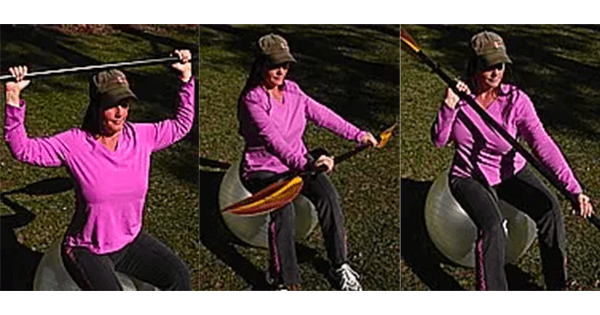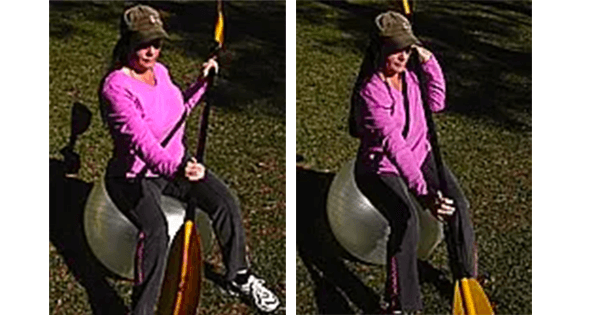Forward Stroke Strengthening
This series of specific exercises for paddlers encourages the use of the Pilates Ball to help improve balance. When learning the art of sea kayaking, the main focus for beginners and novice paddlers is the ability to maintain balance while in the kayak. For most paddlers, just starting out in the sport, this can feel a lot like walking on a tight wire hundreds of feet off the ground. Even an advanced paddler, after a long season off the water, may feel a little "tippy" their first day back in the boat.
Working on "leaning" and "edging", J leans and C leans, can really push the beginner and novice to their limits. The trick is to train the inner ear to find its "center" while performing these tricky balancing acts. The following exercises using the Pilates Ball will help in training, not only the inner ear, but the whole body as well. These are great exercises for fine-tuning maneuvers and offers some great off-season maintenance.
Pilates Ball & Forward Stroke: (Endurance & Balance)
Begin by sitting on top of the pilates ball (inflate the ball so it is very firm) with a paddle, broom stick or long dowel in hand.

- Start the exercise with both feet shoulder width apart for balance. As you advance in your technique, bring your feet closer together. The goal is to perform this exercise with the feet crossed.
- Find your hand position on the paddle by placing the loom on your head. Now, with your upper arms horizontal, move your hands until the forearms are vertical.
- Begin the stroke with the leading arm straight, as if reaching for the bow of the kayak.
- The opposite arm should be positioned with the elbow back, just behind the hip, and low with a slight twist in the torso. (As you advance in training you can alter this stroke by bringing the elbow higher.)
- While keeping your leading arm straight, make the paddle pivot in the lead hand by pushing the loom away from your body using the shoulder and tricep of your opposite arm.
- Make an effort to not pull the retreating blade back at this point. This will be done by twisting the upper body in the direction of your stroke. (Note both arms are straight while Teresa is twisting.)

- As the body completes the rotation and the new lead arm is fully extended, Begin to bend the elbow of the retreating arm.
- (Note the position of the lead blade in this picture, the power face is turned up.)
- As you bend the elbow and bring the hand to the shoulder, twist the wrist back to "throttle up" the blade.
- This, twist of the wrist, has now placed the blade with the power face down to the water. (Note the rotation of the blade in both pictures.)
- The upper torso should be twisted in the direction of your stroke and the chest parallel to the paddle. The leading arm should be straight reaching for the bow of the kayak.
Now, link the strokes together and find your rhythm. Start with a slow pace and, as you become comfortable with your form, begin to pick up the speed. Thirty minutes, at a fast pace, will make a good workout.
Tony Kramer is the founder of The Sea Kayaker which is a kayak-touring outfitter serving Atlanta, Georgia and Eastern Shore of the Mobile Bay area. They offer scheduled and custom, guided, sea kayak tours and instruction.
He is also known for his work with Walter Muellenhagen on their "How To" home improvement series: "Hands On" and "Remodeling and Decorating Today." Both shows air on HGTV and DIY. Tony takes this same "How To" approach to his kayak instruction and tours. As an instructor, his experience is based on over seventeen years of open ocean touring and BCU training.
Related Articles
If you capsize and have to swim back to shore, swimming with your paddle will be a lot easier and…
This is a favorite topic of mine- linking strokes and how you combine movements, maneuvers, and strokes.…
Lots of paddlers spend a good amount of time figuring out which kayak they are going to buy. A lot less…
Whether you paddle calm water or white water, an inflatable kayak offers a lightweight, accessible boat…



